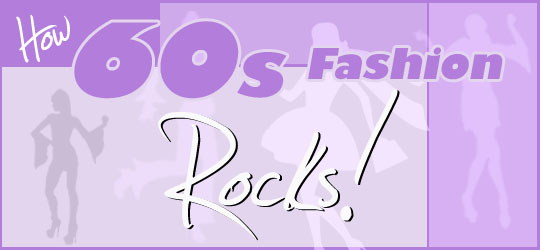
1960s Fashion and Style Primer
• 1960s Style |
• Top ’60s Articles |
• 1960s Fashion Trends |
• 1960s Cultural Influences |
• Recent ’60s Articles |
• 1960s Fashion Resources |
• Signs It Might Be ’60s |
• 1960s Clothes Online |
1960s Style
The 1960s was a fashion decade of lightning fast changes as influenced by the era’s various subcultures from hipsters to hippies; beatniks to mods to swingers. An era of sweeping social and political change, the fashion trends were fast-moving and quickly commercialized by designers from “underground” origins to the mainstream.
Some of today’s most popular trends were invented in the ‘60s, including Mary Quaint’s mini skirt, the knee-high boot, First Lady Jackie O’s leopard print coat, bell bottom flared jeans and Yves Saint Laurent’s groundbreaking pant suit and “Le Smoking” tuxedo jacket for women.
1960s Style Dresses from Shabby Apple

<< SHOP NOW: Authentic & awesome 1960s vintage clothing from eBay!
‘60s fashion was remembered most for the Youthquake Movement. The movement was born in London amongst teenage trendsetters with disposable income and the goal of differentiating themselves from the mainstream.
Youthquakers wore the latest, most experimental styles made for them by up and coming designers looking to popularize their tastes. These hipsters ironically set the trends for the mainstream that they were differentiating themselves from in the first place.
Other fashion influences were born out of the era’s obsession with travel, whether man’s travel into space or designer’s exploration of the Middle East.
Velvet and brocade materials, color blocking and psychedelic designs as well as graphic lines, waistless “bag” dresses and Edwardian-Victorian styles also influenced the many trends of ‘60s women’s fashion.
Fashion Trends of the 1960s
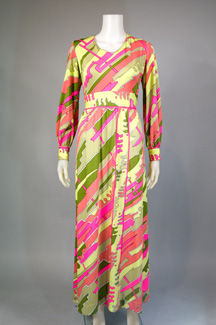 |
Italian designer Emilio Pucci’s prints were some of the most mimicked in the 1960s, as illustrated here with this very Pucci print lookalike maxi dress by a no-name label.
Known for geometric shapes in a kaleidoscope of colors on top quality stretch fabrics and silks, the “Pucci print” exploded stateside in the ‘60s because it was so appropriate for the bright, bold and psychedelic styling of the marvelously mod era. The jet setting crowd loved to wear a Pucci print (real or faux) when on vacation, especially to Pucci’s Mediterranean stomping grounds a la Italy, Greece and the Island of Capri. |
| This dress captures the mod look for the ‘60s girl with its trippy floral print in off kilter hues on a waist less “tent” dress that hit above the knee or if she dared, even higher!
Mod meaning “modernist” which translated to the popular of-the-right-now styles of its day, the subculture originated in London and thanks to the advances of technology, was introduced stateside through music, magazines and television. A girl could thus wear a mod dress without really being a true “mod,” who popularized a style of dressing influenced by reckless behaviors, drug culture and materialism for trends. |
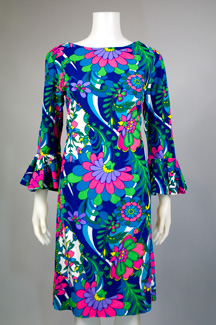 |
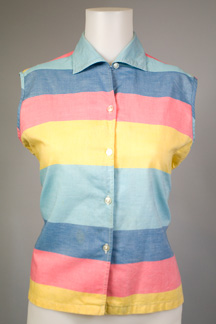 |
Color blocked clothing like this sleeveless top began in the ‘60s as an extension of the London subculture’s bold and experimental mod style. Handbags, shoes, scarves and other accessories were often colorblocked in springy pastels like lemonade yellow, bubblegum pink, baby blue and mint green.
Although originating first with the mods, this repetition of “blocks” of color in modular shapes or geometric stripes hit the mainstream when Yves Saint Laurent introduced his colorblock Mondrian dress in 1965. It became a frequently copied dress of the era and modern reproductions are still being produced today. |
| This Indian cotton printed top carries influences of the Eastern cultures so eagerly embraced for individuality sake by the hippie movement, whose back-to-nature aesthetic of living at natural levels with the planet and its people inspired an anti-fashion movement consisting of secondhand clothes picked from cultures around the globe.
This alternative clothing world didn’t stay alternative for long, as designers were inspired to go against the grain and interpret the ethnic look for the mainstream. Shop owners also imported clothing from the likes of India and Thailand (this top being an example) for Americans to purchase locally. |
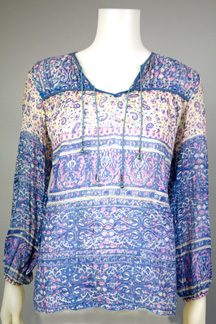 |
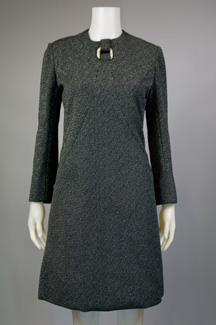 |
<h3 “> Space Age Bill Blass DressMan’s orbit into space in 1961 inspired designers to draw inspiration from beyond Earth’s limits, making minimalist clothing in shimmery silvers, whites and blacks that were simple in design and clean in cut and shape.This Bill Blass dress captures the futuristic ethos of the era because it was designed to fit and function with ease-of-movement as if intended to be worn floating in a gravity-less environment. Andre Courreges and Pierre Cardin were some of the most space-inspired designers; Courreges even created a “Moon Girl” collection in 1964 featuring clothing fit for street walking or moon walking. |
| A little bit naughty, a little bit nice, this scarlet red babydoll dress has a flared skirt with light pleating and lining of tulle below for a fuller fit. It was was worn for evening affairs with tights and Mary Jane shoes.
The trend for wearing velvet in the ‘60s (from head-to-toe suiting for men to jumpsuits and dresses for women) was an extension of the era’s Edwardian style trend beginning around 1966 when rockers like Mick Jagger of the Rolling Stones were photographed sporting the “dandy peacock look” wearing secondhand Edwardian finds from London’s flea market stalls. |
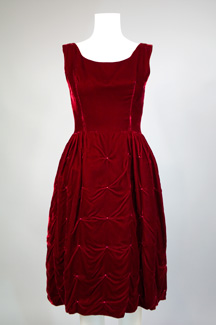 |
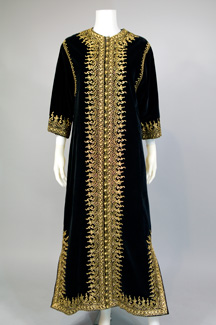 |
Elaborate caftans such as this became popular at-home hosting wear (called “hosting gowns”) for women in the ‘60s that was both elegant and comfortable for entertaining guests.
Because flying was a more accessible, lower-priced mode of travel than previous decades, designers were able to easily visit and be inspired by the fashions and designs of Eastern cultures. While caftans were worn by many cultures, the typical caftan of the era was inspired mostly by styles of Morocco, which was a popular travel destination for explorative vacationers and artists alike. |
| Brocade fabrics with silver and gold metallic threading gave women a royal look while still wearing simple shift dress shapes cut waistless and relaxed on the body. The era’s increase in foreign travel allowed designers to purchase brocade materials (made from organza silk) from abroad to use for reproduction of American styles stateside.
King Saud of Saudi Arabian personally gifted Jacqueline Kennedy brocade material which she had made into this dress by Joan Morse for a La Carte she wore for the musical performance of “Mr. President” in 1962. |
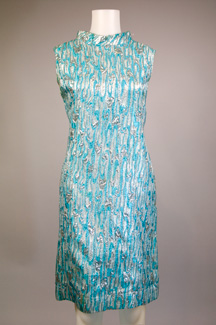 |
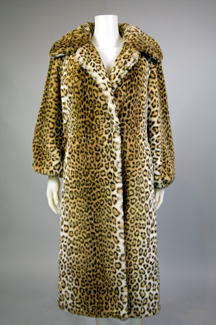 |
After American first lady Jacqueline Onassis Kennedy wore a real leopard coat designed for her by Oleg Cassini, every American woman needed to add a bit of leopard to her life to emulate the decade’s First Lady of Fashion. Leopard print coats such as this became the coat du jour for the American mainstream, who looked to Jackie’s style consciousness for their own wardrobe inspiration.
Unlike today where leopard print on every item of clothing material, the ‘60s trend stuck to real and fake furs and focused on outerwear mostly, like swing coats and pillbox hats, another Jackie O staple. |
| The empire waistline — which rises to a line immediately below the chest to create a longer, leaner silhouette of the wearer’s body — was first popular in 19th century fashion, gaining its name from the empire of French emperor Napoleon Bonaparte.
Like the drop waist of the ‘20s was a switch-up in style for the decade, the empire waistline was a step away from tradition during the 1960s. It was incorporated into the era’s new flared jumpsuit trend (above) and styled into empire waist babydoll dresses to satisfy the mad-for-mini trendset. |
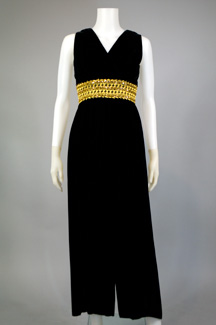 |
 |
Patterned pantsuits of matching jackets, vests and flared low-rise pants were popular to wear for a 9-to-5 job by day and into the night for evening events, since social conventions no longer dictated that women wear dresses in all formal settings.
Women’s pantsuits were more feminine design in nature, such as this with a scalloped neckline on a vest embroidered with threaded red flowers. While today’s suits are black, brown, white and gray, suits of the ‘60s came in an array of prints, psychedelic prints and varied styling. |
| The mini skirt was a fashion invention that revolutionized how women dressed in the ‘60s and forever after. Designed to show about 6 inches of skin above the knee, the mini’s popularity pushed the limits of dressing that had been previously expected of tasteful women.
While not its technical “inventor” (designer John Bates is said to have experimented first with the style), Mary Quant deserves credit for popularizing the mini by introducing it to the trendy youth of London, whose adoption of the trend for its novelty influenced the rest of the world to desire the rising hemline for themselves. |
 |
Thank you to Hinesite Vintage for loaning vintage clothing for the creation of this article.
Signs It Might Be ’60s
| Clothing Styles
• A-line shift dresses |
Patterns
• Psychedelic colors |
| Material
• Metallic threading |
Accessories
• Knee-high boots |
Construction & Tags
• Metal zippers & serged seams
• Limited applique treatment or use of buttons and fasteners as decoration
• Missing care or fabric material label (wasn’t required before 1971)
• Decorative and colorful label designs
Top ’60s Designers
Andre Courreges: Inspired by Russian and US space exploration, released the “Moon Girl” collection of futuristic design in 1964.
Mary Quaint: Popularized the mini skirt among London’s mod set in the mid 1960s.
Biba: Created trend for wearing head-to-toe prints in cheap, disposable clothing.
Yves Saint Laurent: Invented the Mondrian colorblock dress in 1965 and Le Smoking tuxedo jacket in 1966.
Pierre Cardin: His avant garde, futuristic styling was used to dress characters of the popular ‘60s spy show The Avengers.
Emilio Pucci: Popularized psychedelic prints on synthetic stretch fabrics.
Thea Porter: Drew inspiration from Middle Eastern styles and romantic, feminine designs.
Laura Ashley: Designed with old world nostalgia inspired by Edwardian and Victorian prints re-purposed into floral shift dresses.
Givenchy: Designed Holly Golightly’s famous Little Black Dress as worn in 1961’s Breakfast at Tiffany’s. Also inventor of the era’s most popular dress style, called a “bag” or “sack” dress because it lacked a defined waist.
Cultural Influences on the 1960s
Beatnik Cultures: An intellectual movement which rejects materialism also rejects fashion trends and is a precursor to the era’s later anti-fashion hippie movement.
London “Mod” Style: The city’s “youthquake” of teens and 20-somethings embracing fashion as vehicle for independence and self-expression against the “Old Guard”.
Space Exploration: Man’s first flight into space in 1961 inspires futuristic fashions of metallic threading, silver sheen, iridescent materials and clothing of hard lines and simple styling.
Androgyny: Young women wearing their boyfriend’s clothes, the masculine cut “Le Smoking” tuxedo jacket and growing acceptance of women’s pants in formal social situations continues to blur the lines between female and male dressing.
Eastern Cultures: Increased foreign travel introduces designers to the styles, designs and materials of countries like Morocco, India and other Middle Eastern countries.
Psychedelia: Designer Emilio Pucci’s prints start a movement for loud, vibrant and colorful kaleidoscope prints.
Hippie Flower-Power Movement: Designers are inspired by the back-to-nature, Edwardian-inspired fashions of San Francisco hippies who wear secondhand clothing as a statement against fashion trends.
Top ’60s Articles
1. 10 Ways the 1960s Invented Today’s Fashion Trends
2. 1960s Fashion Breakout Trends as Seen on Mad Men
3. ’60s Fashion Outfits from McCall’s Magazine
1960s Fashion Resources
1960s Fashion History by Fashion-Era.com
Pictures of 1960s Fashion by Fashion-Pictures.com
The 1960s in Fashion by Wikipedia.com
1960s Trends by the Year by Paperpast.com
’60s Fashion & Culture by Retrowow
1960s Fashion Reflections by The Gathering Goddess
1960s Clothes Online
1960s Clothing on Etsy.com
1960s Clothing on Style.ly
1960s Clothing on Ebay.com
1960s Clothing Sellers
1960s Clothing on Rustyzipper.com
1960s Dresses on Neldasvintageclothing.com
1960s Dresses on Coutureallure.com
1960s Outfits
1960s Style Outfit of the Day from Your Vintage Life
The Latest 1960s Dresses from Shabby Apple

Wonderful blog! Do you have any suggestions for aspiring writers?
I’m planning to start my own website soon but I’m a little lost on everything. Would you advise starting with a free platform like WordPress or go for a paid option? There are so many choices out there that I’m completely overwhelmed .. Any tips? Cheers!
Hey there! WordPress is wonderful. I highly recommend it! Vintage love, Sammy
gosh,
Thank you so much Sammy for building this site and hope you don’t mind my input. The clothes shown above were not what teenagers and young twenties wore in London in the ’60’s and maybe that is not what you are saying but as your site is going on record for future generations I thought it would be important to note this. Probably the clothes you show were worn in the US or by older (maybe 30’s women) at the time.
Also Biba’s clothes were innovative and chic. I used to go to her 2nd boutique as a teenager. Looking up online I haven’t seen much of the outfits that I used to see back then. I used to go to her Kensington Church street shop. Later when she went upscale (her 3rd boutique) the clothes were fashioned more for 20’s women and were more expensive. Which as a teenager I found very disappointing.
Mary Quant was know mostly for the amazing Op Art designs on the fabric of her clothes. Not sure if she was the first one to do this but her designs were radical.
Bell bottoms were in; velvet jeans; long knitted cardigans; granny shoes and sandals; maxi coats; crocheted tops and dresses; girls wearing short boys sweaters; ankle boots or knee high boots; chiffon was in with flouncy necklines but tasteful colours; platform shoes; leather skirts; levi’s became popular in the 60’s; short A line dresses; dresses with elastic under the bust that then flared out a bit; a lot of fabrics from Morocco and India; long velvet jackets and waistcoats; double breasted long jackets; blouses with two long flowing ties at the neck line to knot; genuine embroidered eastern european peasant blouses. It’s fun reminiscing.
Thank you Sammy. :-)